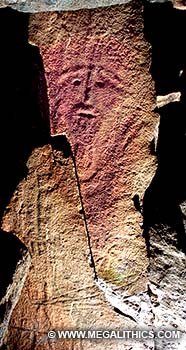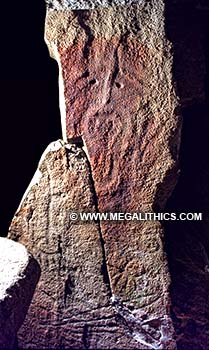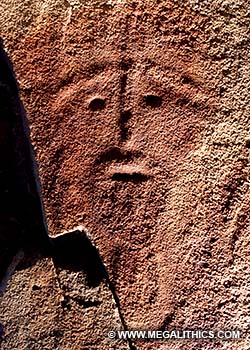 |
 |
 |
||
| Lower right illumination | Upper left illumination | Close up of face |
Theoretically, the presence of this carving
could have been detected at any point after 1847, by this time Lukis
had excavated beneath both pieces of the second capstone, but it was not noticed
for another 68 years.
In 1915 Col. de Guerin carried out a re-excavation of the monument and spotted a
carved crescent on the underside of
second capstone (3), this carving is visible at the bottom of two of the photos
below. This discovery prompted
a minute examination of the entire under surface of the stone and led to
the discovery (4) of the carved figure now
know as "Le Gardien du Tombeau".
Click images below for high resolution pictures, "top" is NW.
The most striking feature of the carving is
the face, this is easily visible on-site today due to modern illumination. The
face has been described
by various authorities as being male, and by others as female, we have to say
that on examination of our photos we definitely lean towards male,
unless bearded ladies were more common in antiquity.........
Beneath the face there are two arms which terminate in ball-like hands with
protruding fingers, below these are four lines making up the
crescent that de Guerin first spotted. Below the crescent is a line that runs
across the whole face of the stone, various circles and semi
circles are associated with this, unfortunately only one of our photos shows a
part of this area.
The figure was almost certainly carved before its installation as a roof stone as
the right arm carving was originally covered by the top of the central
supporting pillar, which appears to be an undisturbed part of the primary
structure. The similarity of the carved stone to French style statue mehirs (of which
there are two free standing examples still to be found on Guernsey) has led to
the speculation that this stone was re-used in the construction of the monument.
The various published drawings of the
carving we have seen all differ from each other and none exactly match the
details revealed in our
low-angle illumination photos above. The area towards the "bottom" (south) of
the stone is the area most at variance between the various depictions
and sadly we did not cover all of this. This stone really needs a surface
scanning technique, either laser or photogrammetric, to obtain
a genuinely objective record of the carving.
|
|